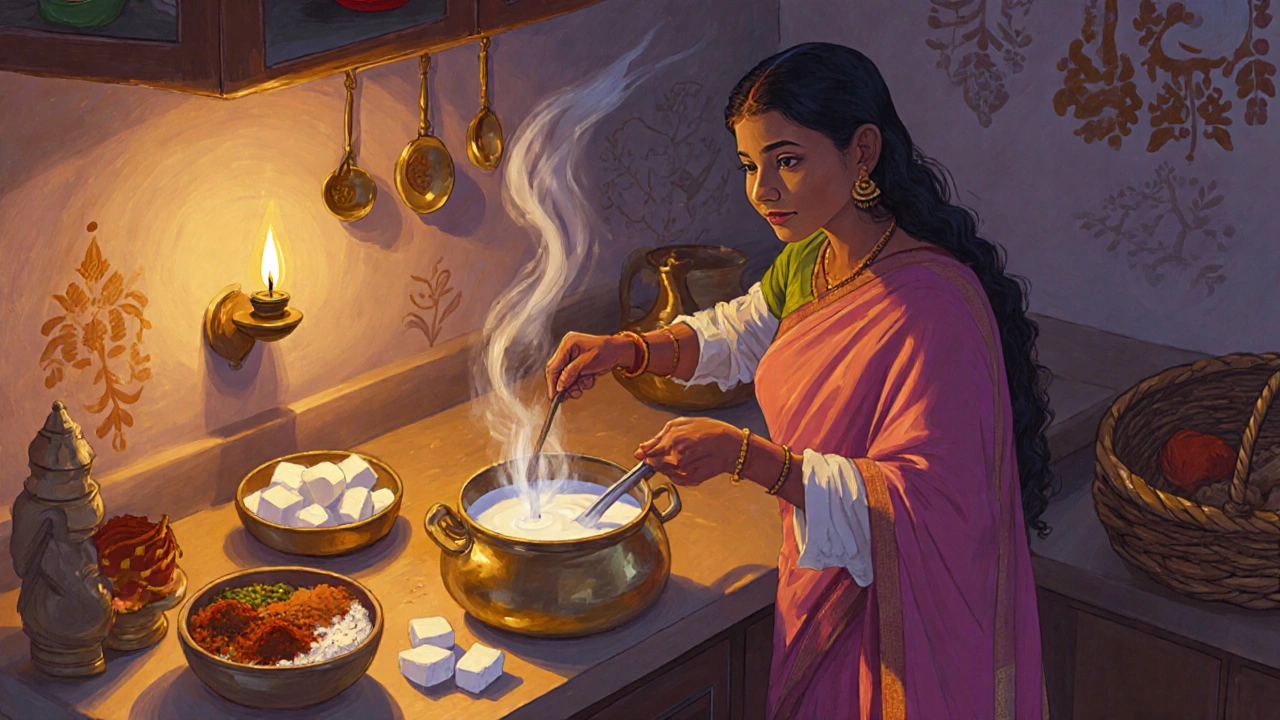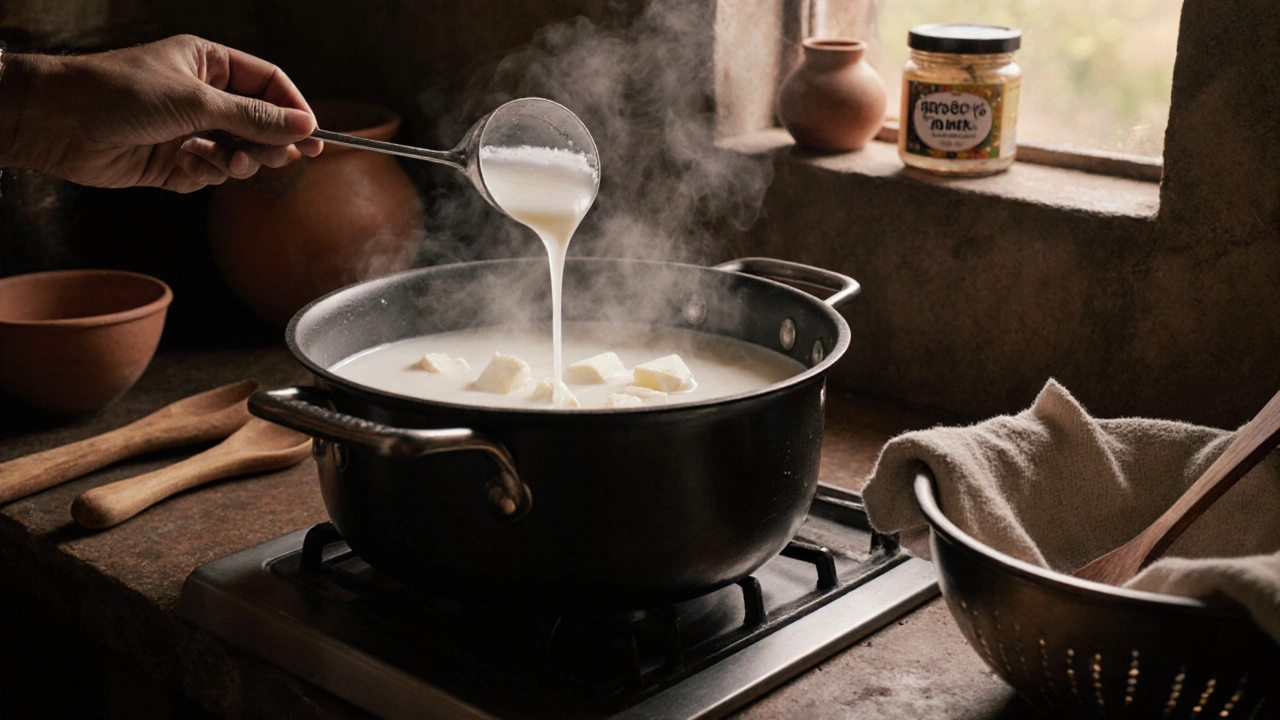When you’re making homemade paneer, lemon juice is the go-to for curdling milk. But what if you run out? Or maybe you don’t like the tangy taste it leaves behind? Or perhaps you’re cooking for someone with a citrus allergy? The good news is, you don’t need lemon to make soft, fresh paneer. There are several simple, effective substitutes that work just as well - and some even give you better results.
Why Lemon Is Used in Paneer
Lemon juice works because it’s acidic. The citric acid lowers the pH of the milk, causing the proteins (casein) to clump together and separate from the whey. That’s how you get solid curds you can press into paneer. But lemon isn’t the only acid that can do this. Many traditional Indian kitchens use other souring agents, especially in regions where citrus isn’t common or is too expensive.
Best Substitutes for Lemon in Paneer
Here are the top five substitutes, ranked by how well they work and how commonly they’re used in homes across India.
1. Vinegar (White Distilled or Apple Cider)
Vinegar is the most reliable lemon substitute. Use white distilled vinegar for a neutral flavor, or apple cider vinegar if you don’t mind a slight fruity note. Add it slowly - about 1 to 2 tablespoons per liter of milk - while the milk is hot but not boiling. Stir gently. You’ll see the curds separate within seconds. The paneer turns out firm and clean-tasting, with no sour aftertaste if you rinse it well.
Pro tip: Start with 1 tablespoon. If the curds don’t form after a minute, add another teaspoon. You can always add more, but you can’t take it out.
2. Yogurt (Plain, Unsweetened)
This is the traditional method used in many North Indian households, especially in Punjab and Haryana. Add 2 to 3 tablespoons of plain yogurt to hot milk and stir well. Let it sit for 5 minutes. The lactic acid in yogurt gently curdles the milk, giving you a softer, creamier paneer. It’s perfect for dishes like paneer butter masala or shahi paneer where you want a delicate texture.
Important: Use only plain, unsweetened yogurt. Flavored or sweetened yogurt will ruin the taste. And don’t use Greek yogurt - it’s too thick and won’t mix evenly.
3. Citric Acid Powder (Food Grade)
If you’ve ever made cheese at home, you’ve probably used citric acid powder. It’s the exact same acid found in lemons, just in concentrated form. Use just 1/4 teaspoon per liter of milk. Dissolve it in a little cold water first, then stir it into the hot milk. It works fast, cleanly, and leaves no flavor behind. Many professional chefs and home cooks who make paneer regularly keep a small jar of this on hand.
It’s cheaper than buying lemons every time, and you can store it for months. You’ll find it in Indian grocery stores labeled as “paneer ka namak” or “cheese making acid.”
4. Buttermilk
Leftover buttermilk from making lassi or chaas? Don’t throw it out. Use 1/4 to 1/2 cup per liter of milk. It’s naturally acidic from fermentation and gives paneer a slightly sweet, milky flavor. The texture is tender and perfect for frying or grilling. This method is common in rural kitchens where dairy is fresh and waste is rare.
5. Tamarind Paste (for a different flavor profile)
If you want paneer with a deeper, fruity sourness - like in some South Indian curries - tamarind paste works surprisingly well. Use 1 teaspoon of paste per liter of milk. It adds a subtle tang and a hint of sweetness. The paneer will be slightly darker in color, but the flavor pairs beautifully with coconut-based gravies or spicy chutneys.
Just strain the paste through a fine sieve before adding it to avoid bits of fiber in your paneer.
What Not to Use
Some substitutes sound logical but don’t work - or make things worse.
- Orange or lime juice: These are citrus too. They’ll work, but they add a strong flavor you might not want. Stick to lemon alternatives if you’re avoiding citrus entirely.
- Sour cream or cream cheese: These are already curdled dairy. Adding them won’t curdle fresh milk - it’ll just make a mess.
- Vinegar with additives: Avoid seasoned or flavored vinegars (like garlic or herb vinegar). Stick to plain white or apple cider.
- Baking soda: This is alkaline. It will prevent curdling, not cause it. Don’t use it.

How to Adjust for Different Results
The texture of your paneer depends on how much acid you use and how long you press it.
- Soft paneer: Use less acid (like 1 tbsp vinegar or 2 tbsp yogurt) and press for only 15-20 minutes under a light weight.
- Firm paneer: Use more acid (like 1/4 tsp citric acid) and press for 45-60 minutes under a heavy pot or book.
- Flavor-neutral paneer: Rinse the curds under cold water for 30 seconds after draining. This removes any residual sourness from the acid.
Pro tip: Always use full-fat milk. Skim or low-fat milk won’t curdle properly and gives you rubbery, low-yield paneer.
Why These Substitutes Work Better Than You Think
Many people think lemon is the only way because it’s popular in blogs and videos. But in real Indian homes, especially in villages and small towns, people use what’s available. Vinegar is cheaper. Yogurt is always in the fridge. Citric acid lasts for years. These aren’t hacks - they’re practical, time-tested methods.
One study from the National Dairy Research Institute in Karnal found that paneer made with citric acid had a higher yield (22% more paneer per liter of milk) than paneer made with lemon juice. That’s because citric acid curdles milk more efficiently, with less waste.

What to Do If Your Paneer Doesn’t Curdle
If the milk doesn’t separate after adding your substitute, here’s what to check:
- Is the milk boiling? It needs to be at a rolling boil (around 95°C). If it’s lukewarm, nothing will happen.
- Did you use pasteurized milk? Ultra-pasteurized or UHT milk often won’t curdle because the proteins are too damaged. Stick to regular pasteurized milk.
- Did you stir gently? Aggressive stirring breaks up the curds. Stir just enough to mix the acid in.
- Did you wait? Sometimes it takes 2-3 minutes for the curds to fully form. Don’t rush it.
If all else fails, add another teaspoon of your substitute and wait. It’ll work.
Final Thoughts: No Lemon? No Problem
You don’t need lemon to make great paneer. In fact, many of these substitutes give you more control over flavor and texture. Vinegar gives you clean, firm paneer. Yogurt gives you soft, creamy paneer. Citric acid gives you consistent results every time. Choose based on what you have - and what you want your dish to taste like.
Next time you’re making paneer, try one of these. You might find you like the result better than lemon. And if you do, you’ll never go back.
Can I use lime instead of lemon for paneer?
Yes, lime works the same way as lemon because it’s also citrus. But it adds a stronger, more floral flavor that can overpower delicate paneer dishes. If you’re making a curry with bold spices, it’s fine. For mild dishes like paneer tikka or palak paneer, stick to vinegar or citric acid for a cleaner taste.
Why does my paneer turn out too crumbly?
Crumbly paneer usually means you used too much acid or pressed it too hard. Reduce the amount of vinegar or citric acid by half a teaspoon next time. Also, press for less time - 30 minutes instead of an hour. And always use full-fat milk. Low-fat milk makes weak curds that fall apart.
Can I use lemon zest instead of juice?
No. Lemon zest contains oils and flavor compounds, but almost no citric acid. It won’t curdle the milk. You need the acid, not the aroma. Stick to juice or one of the other substitutes listed.
Is citric acid safe to use in paneer?
Yes. Food-grade citric acid is approved by health agencies worldwide, including the FDA and FSSAI in India. It’s naturally found in citrus fruits and used in many cheeses and processed foods. Just use the right amount - 1/4 teaspoon per liter of milk - and you’re fine.
How long does paneer made without lemon last?
Same as paneer made with lemon - about 3 to 4 days in the fridge if stored in water. Change the water daily to keep it fresh. If you freeze it, it lasts up to 3 months. The type of acid you use doesn’t affect shelf life.
Next Steps
Try making paneer this weekend with vinegar instead of lemon. Compare the texture and taste. You might be surprised. Once you get comfortable with substitutes, experiment with yogurt for soft paneer or citric acid for firm blocks. Keep notes on what works best for your favorite recipes.
And if you ever run out of milk? That’s another problem - but for now, you’ve got more than enough ways to make paneer without lemon.
